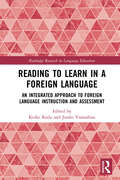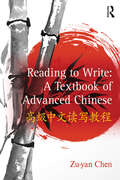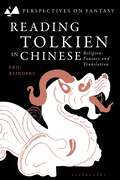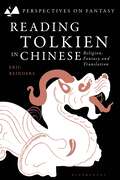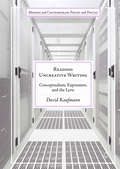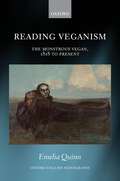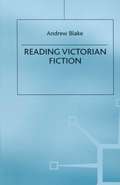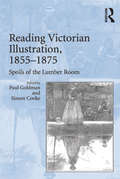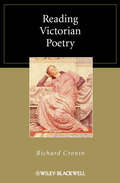- Table View
- List View
Reading to Learn in a Foreign Language: An Integrated Approach to Foreign Language Instruction and Assessment (Routledge Research in Language Education)
by Keiko Koda Junko YamashitaThis book describes a theory-guided approach to Foreign Language (FL) course development, implementation, instruction and assessment. It documents the development and implementation of a theory-guided approach designed to exploit cross-linguistically sharable competencies as resources for promoting FL learning. The volume delineates the processes of (a) identifying cross-linguistically sharable competencies, (b) exploring ways of exploiting sharable competencies as resources in promoting language skills through their purposeful use for content learning, (c) implementing the instructional approach in multiple EFL classrooms, and (d) evaluating the approach by comparing learning outcomes across classrooms. It presents a solid conceptual framework that integrates theories in multiple research domains, including second language acquisition, knowledge acquisition, and language assessment. It also provides detailed descriptions of framework construction and classroom implementation – the two processes that are integral to course design and development.
Reading to Write: A Textbook of Advanced Chinese
by Zu-Yan ChenTraditionally, reading and writing are believed to be separate but related language processes and teachers follow the conventional wisdom of teaching in-depth reading, with writing as a tag-on issue. Therefore, there exists an increasingly urgent call for a well-rounded reading-writing curriculum and a theoretically-informed, empirically-based, student-centered advanced textbook that aims to develop the synergy between reading and writing. Reading to Write: A Textbook of Advanced Chinese is intended to fill this significant gap. It treats reading and writing as integrative parts and interactive skills in Chinese language teaching, putting them hand-in-hand, supplementing each other.
Reading to Write: A Textbook Of Advanced Chinese
by Zu-yan ChenTraditionally, reading and writing are believed to be separate but related language processes and teachers follow the conventional wisdom of teaching in-depth reading, with writing as a tag-on issue. Therefore, there exists an increasingly urgent call for a well-rounded reading-writing curriculum and a theoretically-informed, empirically-based, student-centered advanced textbook that aims to develop the synergy between reading and writing. Reading to Write: A Textbook of Advanced Chinese is intended to fill this significant gap. It treats reading and writing as integrative parts and interactive skills in Chinese language teaching, putting them hand-in-hand, supplementing each other.
Reading-to-Write: Exploring a Cognitive and Social Process (Social and Cognitive Studies in Writing and Literacy)
by Linda Flower Victoria Stein John Ackerman Margaret J. Kantz Kathleen McCormick Wayne C. PeckThe Social and Cognitive Studies in Writing and Literacy Series, is devoted to books that bridge research, theory, and practice, exploring social and cognitive processes in writing and expanding our knowledge of literacy as an active constructive process--as students move from high school to college. This descriptive study of reading-to-write examines a critical point in every college student's academic performance: when he or she is faced with the task of reading a source, integrating personal ideas, and creating an individual text with a self-defined purpose. Offering an unusually comprehensive view of this process, the authors chart a group of freshmen as they study and write in their dormitories, recording their "think-aloud" strategies for reading, writing, and revising, their interpretation of the task, and their broader social, cultural, and contextual understanding of college writing. Flower, Stein, and colleagues convincingly conclude that the legacy of schooling in general makes the transition to college difficult and, more important, that the assumptions students hold and the strategies they use in undertaking this task play a significant role in their academic performance. Embracing a broad range of perspectives from rhetoric, composition, literacy research, literary and cultural theory, and cognitive psychology, this rigorous analysis treats reading-to-write as both a cognitive and social process. It will interest researchers and theoreticians in rhetoric and writing, teachers working with students in transition from high school to college, and educators involved in the links between cognition and the social process.
Reading Tolkien in Chinese: Religion, Fantasy and Translation (Perspectives on Fantasy)
by Mr Eric ReindersApproaching translations of Tolkien's works as stories in their own right, this book reads multiple Chinese translations of Tolkien's writing to uncover the new and unique perspectives that enrich the meaning of the original texts. Exploring translations of The Lord of the Rings, The Hobbit, The Silmarillion, The Children of Hurin and The Unfinished Tales, Eric Reinders reveals the mechanics of meaning by literally back-translating the Chinese into English to dig into the conceptual common grounds shared by religion, fantasy and translation, namely the suspension of disbelief, and questions of truth - literal, allegorical and existential. With coverage of themes such as gods and heathens, elves and 'Men', race, mortality and immortality, fate and doom, and language, Reinder's journey to Chinese Middle-earth and back again drastically alters views on Tolkien's work where even basic genre classification surrounding fantasy literature look different through the lens of Chinese literary expectations.Invoking scholarship in Tolkien studies, fantasy theory and religious and translations studies, this is an ambitious exercises in comparative imagination across cultures that suspends the prejudiced hierarchy of originals over translations.
Reading Tolkien in Chinese: Religion, Fantasy and Translation (Perspectives on Fantasy)
by Mr Eric ReindersApproaching translations of Tolkien's works as stories in their own right, this book reads multiple Chinese translations of Tolkien's writing to uncover the new and unique perspectives that enrich the meaning of the original texts. Exploring translations of The Lord of the Rings, The Hobbit, The Silmarillion, The Children of Hurin and The Unfinished Tales, Eric Reinders reveals the mechanics of meaning by literally back-translating the Chinese into English to dig into the conceptual common grounds shared by religion, fantasy and translation, namely the suspension of disbelief, and questions of truth - literal, allegorical and existential. With coverage of themes such as gods and heathens, elves and 'Men', race, mortality and immortality, fate and doom, and language, Reinder's journey to Chinese Middle-earth and back again drastically alters views on Tolkien's work where even basic genre classification surrounding fantasy literature look different through the lens of Chinese literary expectations.Invoking scholarship in Tolkien studies, fantasy theory and religious and translations studies, this is an ambitious exercises in comparative imagination across cultures that suspends the prejudiced hierarchy of originals over translations.
Reading Toni Morrison (The Pop Lit Book Club)
by Rachel ListerThis volume offers students and book club members a handy and insight-filled guide to Morrison's works and their relation to current events and popular culture.One of the few authors to attain both commercial success and literary acclaim, Toni Morrison, a longstanding member of the American Academy of Arts and Letters, is widely read by high school students and general readers. Her books have been adapted into highly extolled films such as Beloved, largely because, even when set in the past, they grapple with issues and emotions relevant to contemporary society. Designed for students and general readers, Reading Toni Morrison is a handy introduction to Morrison's works and their place in the world. The book begins with a look at Morrison's life and writing. Chapters overview the plots of her novels and discuss their themes, characters, and contexts. The book then examines Morrison's treatment of social issues and the presence of her works in popular culture. Chapters provide sidebars of interesting information along with questions to promote student research and book club discussion.
Reading Typographically: Immersed in Print in Early Modern France (Stanford Text Technologies)
by Geoffrey TurnovskyAnxieties about the fate of reading in the digital age reveal how deeply our views of the moral and intellectual benefits of reading are tied to print. These views take root in a conception of reading as an immersive activity, exemplified by the experience of "losing oneself in a book." Against the backdrop of digital distraction and fragmentation, such immersion leads readers to become more focused, collected, and empathetic. How did we come to see the printed book as especially suited to deliver this experience? Print-based reading practices have historically included a wide range of modes, not least the disjointed scanning we associate today with electronic text. In the context of religious practice, literacy's benefits were presumed to lie in such random-access retrieval, facilitated by indexical tools like the numbering of Biblical chapters and verses. It was this didactic, hunt-and-peck reading that bound readers to communities. Exploring key evolutions in print in 17th- and 18th-century France, from typeface, print runs, and format to punctuation and the editorial adaptation of manuscript and oral forms in print, this book argues that typographic developments upholding the transparency of the printed medium were decisive for the ascendancy of immersive reading as a dominant paradigm that shaped modern perspectives on reading and literacy.
Reading Typographically: Immersed in Print in Early Modern France (Stanford Text Technologies)
by Geoffrey TurnovskyAnxieties about the fate of reading in the digital age reveal how deeply our views of the moral and intellectual benefits of reading are tied to print. These views take root in a conception of reading as an immersive activity, exemplified by the experience of "losing oneself in a book." Against the backdrop of digital distraction and fragmentation, such immersion leads readers to become more focused, collected, and empathetic. How did we come to see the printed book as especially suited to deliver this experience? Print-based reading practices have historically included a wide range of modes, not least the disjointed scanning we associate today with electronic text. In the context of religious practice, literacy's benefits were presumed to lie in such random-access retrieval, facilitated by indexical tools like the numbering of Biblical chapters and verses. It was this didactic, hunt-and-peck reading that bound readers to communities. Exploring key evolutions in print in 17th- and 18th-century France, from typeface, print runs, and format to punctuation and the editorial adaptation of manuscript and oral forms in print, this book argues that typographic developments upholding the transparency of the printed medium were decisive for the ascendancy of immersive reading as a dominant paradigm that shaped modern perspectives on reading and literacy.
Reading U.S. Latina Writers: Remapping American Literature
by A. QuintanaThis essential teaching guide focuses on an emerging body of literature by U.S. Latina and Latin American Women writers. It will assist non-specialist educators in syllabus revision, new course design and classroom presentation. The inclusive focus of the book - that is, combining both US Latina and Latin American women writers - is significant because it introduces a more global and transnational way of approaching the literature. The introduction outlines the major historical experiences that inform the literature, the important genres, periods, movements and authors in its evolution; the traditions and influences that shape the works; and key critical issues of which teachers should be aware. The collection seeks to provide readers with a variety of Latina texts that will guarantee its long-term usefulness to teachers and students of pan-American literature. Because it is no longer possible to understand U.S. Latina literature without taking into consideration the histories and cultures of Latin America, the volume will, through its organization, argue for a more globalized type of analysis which considers the similarities as well as the differences in U.S. and Latin American women's cultural productions. In this context, the term Latina evokes a diasporic, transnational condition in order to address some of the pedagogical issues posed by the bicultural nature which is inherent in pan-American women's literature.
Reading Uncreative Writing: Conceptualism, Expression, and the Lyric
by David KaufmannThis book examines Uncreative Writing—the catch-all term to describe Neo-Conceptualism, Flarf and related avant-garde movements in contemporary North American poetry—against a decade of controversy. David Kaufman analyzes texts by Kenneth Goldsmith, Vanessa Place, Robert Fitterman, Ara Shirinyan, Craig Dworkin, Dan Farrell and Katie Degentesh to demonstrate that Uncreative Writing is not a revolutionary break from lyric tradition as its proponents claim. Nor is it a racist, reactionary capitulation to neo-liberalism as its detractors argue. Rather, this monograph shows that Uncreative Writing’s real innovations and weaknesses become clearest when read in the context of the very lyric that it claims to have left behind.
Reading Uncreative Writing: Conceptualism, Expression, and the Lyric
by David KaufmannThis book examines Uncreative Writing—the catch-all term to describe Neo-Conceptualism, Flarf and related avant-garde movements in contemporary North American poetry—against a decade of controversy. David Kaufman analyzes texts by Kenneth Goldsmith, Vanessa Place, Robert Fitterman, Ara Shirinyan, Craig Dworkin, Dan Farrell and Katie Degentesh to demonstrate that Uncreative Writing is not a revolutionary break from lyric tradition as its proponents claim. Nor is it a racist, reactionary capitulation to neo-liberalism as its detractors argue. Rather, this monograph shows that Uncreative Writing’s real innovations and weaknesses become clearest when read in the context of the very lyric that it claims to have left behind.
Reading Under Control: Teaching Reading in the Primary School
by Judith Graham Alison KellyNow in an updated third edition, this best-selling textbook introduces primary teachers to the key issues in how to teach reading. The authors celebrate reading as an important, exhilarating part of the curriculum with the potential to transform lives, whilst also giving a balanced handling of contentious issues. Strongly rooted in classroom practice, the book provides comprehensive coverage of differing reading practices and resources. Key features include: managing specialized reading difficulties, such as dyslexia EAL and gender issues in reading use of ICT within reading a detailed inspection of the phonics debate. This book is essential reading for both trainee teachers and qualified teachers interested in continuing their professional development.
Reading Under Control: Teaching Reading in the Primary School
by Judith Graham Alison KellyNow in an updated third edition, this best-selling textbook introduces primary teachers to the key issues in how to teach reading. The authors celebrate reading as an important, exhilarating part of the curriculum with the potential to transform lives, whilst also giving a balanced handling of contentious issues. Strongly rooted in classroom practice, the book provides comprehensive coverage of differing reading practices and resources. Key features include: managing specialized reading difficulties, such as dyslexia EAL and gender issues in reading use of ICT within reading a detailed inspection of the phonics debate. This book is essential reading for both trainee teachers and qualified teachers interested in continuing their professional development.
Reading Underwater Wreckage: An Encrusting Ocean (Environmental Cultures)
by Killian QuigleyPresenting a novel and needed theoretical model for interpreting shipwrecks and other drowned fragments-the histories they tell, and the futures they presage-as junctures of artefact and ecofact, human remains and emergent ecologies, this book puts the environmental humanities, and particularly multispecies studies, in close conversation with literary studies, history, and aesthetic theory.Earth's oceans hold the remains of as many as three million shipwrecks, some thousands of years old. Instead of approaching shipwrecks as either artefacts or “ecofacts,” this book presents a third frame for understanding, one inspired by the material dynamism of sea-floor stuff. As they become encrusted by oceanic matter-some of it living, some inanimate-anthropic fragments participate in a distinctively submarine form of material relation. That relation comprises a wide, and sometimes incalculable, array of things, lives, times, and stories. Drawing from several centuries of literary, philosophical, and scientific encounters with encrustations-as well as from some of the innumerable encrusted “art-forms” that inhabit the sea floor- this book serves anyone in search of better ways to perceive, describe, and imagine submarine matters.
Reading Underwater Wreckage: An Encrusting Ocean (Environmental Cultures)
by Killian QuigleyPresenting a novel and needed theoretical model for interpreting shipwrecks and other drowned fragments-the histories they tell, and the futures they presage-as junctures of artefact and ecofact, human remains and emergent ecologies, this book puts the environmental humanities, and particularly multispecies studies, in close conversation with literary studies, history, and aesthetic theory.Earth's oceans hold the remains of as many as three million shipwrecks, some thousands of years old. Instead of approaching shipwrecks as either artefacts or “ecofacts,” this book presents a third frame for understanding, one inspired by the material dynamism of sea-floor stuff. As they become encrusted by oceanic matter-some of it living, some inanimate-anthropic fragments participate in a distinctively submarine form of material relation. That relation comprises a wide, and sometimes incalculable, array of things, lives, times, and stories. Drawing from several centuries of literary, philosophical, and scientific encounters with encrustations-as well as from some of the innumerable encrusted “art-forms” that inhabit the sea floor- this book serves anyone in search of better ways to perceive, describe, and imagine submarine matters.
Reading Vampire Gothic Through Blood: Bloodlines (Palgrave Gothic)
by Aspasia StephanouReading Vampire Gothic Through Blood examines the manifestations of blood and vampires in various texts and contexts. It seeks to connect, through blood, fictional to real-life vampires to trace similarities, differences and discontinuities. These movements will be seen to parallel changing notions about embodiment and identity in culture.
Reading Veganism: The Monstrous Vegan, 1818 to Present (Oxford English Monographs)
by Emelia QuinnReading Veganism: The Monstrous Vegan, 1818 to Present focuses on the iteration of the trope 'the monstrous vegan' across two hundred years of Anglophone literature. Explicating, through such monsters, veganism's relation to utopian longing and challenge to the conceptual category of the 'human,' the book explores ways in which ethical identities can be written, represented, and transmitted. Reading Veganism proposes that we can recognise and identify the monstrous vegan in relation to four key traits. First, monstrous vegans do not eat animals, an abstinence that generates a seemingly inexplicable anxiety in those who encounter them. Second, they are hybrid assemblages of human and nonhuman animal parts, destabilising existing taxonomical classifications. Third, monstrous vegans are sired outside of heterosexual reproduction, the product of male acts of creation. And finally, monstrous vegans are intimately connected to acts of writing and literary creation. The principle contention of the book is that understandings of veganism, as identity and practice, are limited without a consideration of multiplicity, provisionality, failure, and insufficiency within vegan definition and lived practice. Veganism's association with positivity, in its drive for health and purity, is countered by a necessary and productive negativity generated by a recognition of the horrors of the modern world. Vegan monsters rehearse the key paradoxes involved in the writing of vegan identity.
Reading Veganism: The Monstrous Vegan, 1818 to Present (Oxford English Monographs)
by Emelia QuinnReading Veganism: The Monstrous Vegan, 1818 to Present focuses on the iteration of the trope 'the monstrous vegan' across two hundred years of Anglophone literature. Explicating, through such monsters, veganism's relation to utopian longing and challenge to the conceptual category of the 'human,' the book explores ways in which ethical identities can be written, represented, and transmitted. Reading Veganism proposes that we can recognise and identify the monstrous vegan in relation to four key traits. First, monstrous vegans do not eat animals, an abstinence that generates a seemingly inexplicable anxiety in those who encounter them. Second, they are hybrid assemblages of human and nonhuman animal parts, destabilising existing taxonomical classifications. Third, monstrous vegans are sired outside of heterosexual reproduction, the product of male acts of creation. And finally, monstrous vegans are intimately connected to acts of writing and literary creation. The principle contention of the book is that understandings of veganism, as identity and practice, are limited without a consideration of multiplicity, provisionality, failure, and insufficiency within vegan definition and lived practice. Veganism's association with positivity, in its drive for health and purity, is countered by a necessary and productive negativity generated by a recognition of the horrors of the modern world. Vegan monsters rehearse the key paradoxes involved in the writing of vegan identity.
Reading: A Very Short Introduction (Very Short Introductions)
by Belinda JackToday many people take reading for granted, but we remain some way off from attaining literacy for the global human population. And whilst we think we know what reading is, it remains in many ways a mysterious process, or set of processes. The effects of reading are myriad: it can be informative, distracting, moving, erotically arousing, politically motivating, spiritual, and much, much more. At different times and in different places reading means different things. In this Very Short Introduction Belinda Jack explores the fascinating history of literacy, and the opportunities reading opens. For much of human history reading was the preserve of the elite, and most reading meant being read to. Innovations in printing, paper-making, and transport, combined with the rise of public education from the late eighteenth century on, brought a dramatic rise in literacy in many parts of the world. Established links between a nation's levels of literacy and its economy led to the promotion of reading for political ends. But, equally, reading has been associated with subversive ideas, leading to censorship through multiple channels: denying access to education, controlling publishing, destroying libraries, and even the burning of authors and their works. Indeed, the works of Voltaire were so often burned that an enterprising Parisian publisher produced a fire-proof edition, decorated with a phoenix. But, as Jack demonstrates, reading is a collaborative act between an author and a reader, and one which can never be wholly controlled. Telling the story of reading, from the ancient world to digital reading and restrictions today, Belinda Jack explores why it is such an important aspect of our society. ABOUT THE SERIES: The Very Short Introductions series from Oxford University Press contains hundreds of titles in almost every subject area. These pocket-sized books are the perfect way to get ahead in a new subject quickly. Our expert authors combine facts, analysis, perspective, new ideas, and enthusiasm to make interesting and challenging topics highly readable.
Reading: A Very Short Introduction (Very Short Introductions)
by Belinda JackToday many people take reading for granted, but we remain some way off from attaining literacy for the global human population. And whilst we think we know what reading is, it remains in many ways a mysterious process, or set of processes. The effects of reading are myriad: it can be informative, distracting, moving, erotically arousing, politically motivating, spiritual, and much, much more. At different times and in different places reading means different things. In this Very Short Introduction Belinda Jack explores the fascinating history of literacy, and the opportunities reading opens. For much of human history reading was the preserve of the elite, and most reading meant being read to. Innovations in printing, paper-making, and transport, combined with the rise of public education from the late eighteenth century on, brought a dramatic rise in literacy in many parts of the world. Established links between a nation's levels of literacy and its economy led to the promotion of reading for political ends. But, equally, reading has been associated with subversive ideas, leading to censorship through multiple channels: denying access to education, controlling publishing, destroying libraries, and even the burning of authors and their works. Indeed, the works of Voltaire were so often burned that an enterprising Parisian publisher produced a fire-proof edition, decorated with a phoenix. But, as Jack demonstrates, reading is a collaborative act between an author and a reader, and one which can never be wholly controlled. Telling the story of reading, from the ancient world to digital reading and restrictions today, Belinda Jack explores why it is such an important aspect of our society. ABOUT THE SERIES: The Very Short Introductions series from Oxford University Press contains hundreds of titles in almost every subject area. These pocket-sized books are the perfect way to get ahead in a new subject quickly. Our expert authors combine facts, analysis, perspective, new ideas, and enthusiasm to make interesting and challenging topics highly readable.
Reading Victorian Fiction: The Cultural Context and Ideological Content of the Nineteenth-Century Novel
by Andrew BlakeA study of the interrelationship of the Victorian novel with other forms of writings, arguing that the whole literary culture was concerned with the production of Victorian values, including novels, an active part in the compromise between aristocratic and middle class cultures in this period.
Reading Victorian Illustration, 1855-1875: Spoils of the Lumber Room
by Paul GoldmanIn a reevaluation of that period in Victorian illustration known as 'The Sixties,' a distinguished group of international scholars consider the impact of illustration on the act of reading; its capacity to reflect, construct, critique and challenge its audience's values; its response to older graphic traditions; and its assimilation of foreign influences. While focused on the years 1855 to 1875, the essays take up issues related to the earlier part of the nineteenth century and look forward to subsequent developments in illustration. The contributors examine significant figures such as Ford Madox Brown, Frederick Sandys, John Everett Millais, George John Pinwell, and Hablot Knight Browne in connection with the illustrated magazine, the mid-Victorian gift book, and changing visual responses to the novels of Dickens. Engaging with a number of theories and critical debates, the collection offers a detailed and provocative analysis of the nature of illustration: its production, consumption, and place within the broader contexts of mid-Victorian culture.
Reading Victorian Illustration, 1855-1875: Spoils of the Lumber Room
by Paul GoldmanIn a reevaluation of that period in Victorian illustration known as 'The Sixties,' a distinguished group of international scholars consider the impact of illustration on the act of reading; its capacity to reflect, construct, critique and challenge its audience's values; its response to older graphic traditions; and its assimilation of foreign influences. While focused on the years 1855 to 1875, the essays take up issues related to the earlier part of the nineteenth century and look forward to subsequent developments in illustration. The contributors examine significant figures such as Ford Madox Brown, Frederick Sandys, John Everett Millais, George John Pinwell, and Hablot Knight Browne in connection with the illustrated magazine, the mid-Victorian gift book, and changing visual responses to the novels of Dickens. Engaging with a number of theories and critical debates, the collection offers a detailed and provocative analysis of the nature of illustration: its production, consumption, and place within the broader contexts of mid-Victorian culture.
Reading Victorian Poetry (Wiley Blackwell Reading Poetry #9)
by Richard CroninReading Victorian Poetry offers close readings of poems from the Victorian era by a renowned scholar. The selection includes a range of canonical and lesser known writers Skilfully conveys the breadth and diversity of nineteenth-century poetry Offers an ideal balance of canonical and less well-known writers Allows readers to explore the poetry of the Victorian era, through the eyes of one of the most renowned scholars in the field Poets covered include Matthew Arnold, Emily Brontë, Elizabeth Barrett Browning, Robert Browning, Lewis Carroll, A. H. Clough, G. M. Hopkins, Edward Lear, Christina Rossetti, D. G. Rossetti, A. C. Swinburne, Arthur Symons, Alfred Tennyson, Oscar Wilde
